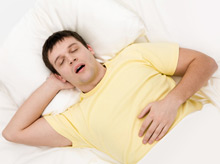Sleep Apnea – Diagnosing OSA
Main article: Breathing Easier
 If a patient complains about being tired and irritable all the time, it could be sleep apnea, says Eric Z. Shapira, DDS, MAGD, an AGD spokesperson in Montara, California. Patients frequently believe that they can’t have OSA, with many of them insisting that they don’t snore, he says. Patients typically view their symptoms as isolated conditions instead of recognizing that all of them combined could be the result of sleep apnea. They also tend to attribute a lack of sleep to external factors such as stress brought on by working long hours, having young children or worrying about the economy.
If a patient complains about being tired and irritable all the time, it could be sleep apnea, says Eric Z. Shapira, DDS, MAGD, an AGD spokesperson in Montara, California. Patients frequently believe that they can’t have OSA, with many of them insisting that they don’t snore, he says. Patients typically view their symptoms as isolated conditions instead of recognizing that all of them combined could be the result of sleep apnea. They also tend to attribute a lack of sleep to external factors such as stress brought on by working long hours, having young children or worrying about the economy.
Look for bloodshot eyes, black circles around the eyes, and puffy eyes. Dentists also might see a coaling on the tongue from mouth breathing, or scalloping on the edges from clenched teeth says Dr Bailey, DDS, FAGD, an AGD member in Colorado who specializes in the treatment of temporo-mandibular disorders (TMD) and the use of intraoral appliances to manage snoring and sleep apnea. “Redness of the soft palate or an enlarged uvula or tongue also can be signs of OSA,” he adds.
Dr Shapira emphasizes the need to obtain a social history to understand the patient’s habits so that signs of other issues aren’t mistaken for OSA Excessive use of Listerine® for example, will dry out the mouth and could indicate a false positive. Breathing obstructions caused by smoking, alcohol use, or enlarged tonsils or adenoids also can be misleading. “It’s one thing lo note the signs, but you have to play detective and investigate causes too,” he says. “Dentists can get a lot of false positives which is why the social history is important.”
Keith Thornton, DDS, a general dentist in Dallas and inventor of the Thornton Adjustable Positioner” (TAP®) oral appliance for sleep apnea says that anecdotal reports rate the patient’s levels of daytime sleepiness which could predict signs of OSA. One such report is the Epworth Sleepiness Scale, introduced in 1991 by Dr. Murray Johns of Epworth Hospital in Melbourne, Australia. “The questionnaire draws an empirical correlation between the information collected on the questionnaire and other predictors, like the Mallampati Score, with the potential for detecting patients who could be at risk for OSA,” says Dr. Bailey.
OSA can include partial (hypopnea) or complete (apnea) closing of the pharynx while a person sleeps says Alejandro Chediak, MD, FACP, immediate past president of the American Academy of Sleep Medicine (AASM) and a Miami, Florida, board-certified specialist in internal medicine, pulmonary diseases arid sleep disorders. “The apnea hypopnea index (AHI) performed during a sleep study is currently the forerunner in the measurement of OSA severity.” AHI indicates the average number of apneas and hypopneas per sleep hour, measured in a sleep laboratory using polysomnography.
Dr. Pancer cautions that symptomology can be a real issue, adding that test results can be misleading. “I’ve seen patients with an AHI of 5, which is very low, yet they were symptomatic for OSA. My own AHI was 45, but I felt great even though my numbers indicated that I had severe OSA.”
Measuring adjusted neck circumference is another diagnostic tool that can be done in the office, a service Dr. Thornton offers in his practice. “The sleep test is a tool, but it is not the end-all” says Dr. Chediak. “It helps the medical doctor plan the best therapy”.
Dr Shapira favours using a conservative approach to rule out other causes such as craniofacial problems or allergies. He concedes that the problem may be sleep apnea but notes that treatments and sleep studies are costly and often are not covered by insurance. “Do your homework first and inform before you perform,” he says.
See also: Sleep Apnea – Studio Dentaire
Leave a comment